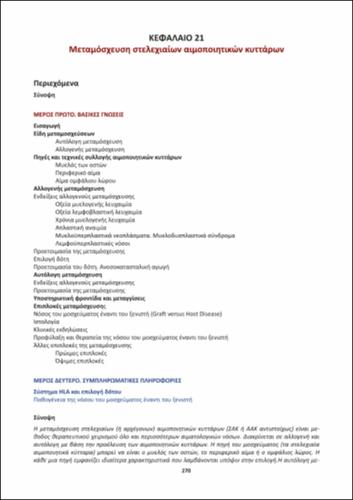| Title Details: | |
|
Hematopoietic stem cell transplantation |
|
| Authors: |
Angelopoulou, Maria |
| Reviewer: |
Konstantopoulos, Konstantinos |
| Subject: | MEDICINE AND HEALTH SCIENCES, LIFE SCIENCES, BIOLOGICAL SCIENCES > HEALTH SCIENCES > MEDICINE > CLINICAL MEDICINE MEDICINE AND HEALTH SCIENCES, LIFE SCIENCES, BIOLOGICAL SCIENCES > HEALTH SCIENCES MEDICINE AND HEALTH SCIENCES, LIFE SCIENCES, BIOLOGICAL SCIENCES > HEALTH SCIENCES > MEDICINE > PATHOLOGY MEDICINE AND HEALTH SCIENCES, LIFE SCIENCES, BIOLOGICAL SCIENCES > HEALTH SCIENCES > MEDICINE > PUBLIC HEALTH > PREVENTIVE MEDICINE |
| Description: | |
| Abstract: |
Hemopoietic Stem Cell Transplantation (HSCT) can be allogeneic or autologous, depending on the origin of the stem cells. The latter are obtained from the marrow, the peripheral blood or the umbilical cord blood. As a rule, autologous HSCT is carried out in various hematological neoplasias (mainly myeloma and lymphomas) and aims at reconstituting normal hemopoiesis following intensive chemotherapy. Allogeneic HSCT is a final therapeutic approach in several hematologic malignancies (mainly AML) and aims at completely replacing the marrow of the recipient with marrow of the donor. It requires availabiity of a suitable donor, an effective ablation of the recipient’s marrow, and the qppropriate preparation of the latter in a way which will allow acceptance of the transplant and avoidance of the Graft vs. Host disease. A possible Graft vs. Leukemia effect is also an additional benefit. Complete histocompatibility is a major factor for success and the selection of the potential donor greatly depends upon his HLA antigens. The donor may be a family member (a sibling as a rule) or a HLA-compatible unrelated person. Inability to ensure a perfect match leads to a series of biological reactions such as the rejection of the transplant and the GvH and GvL effects. Moreover, HSCT is associated with a number of important and difficult to meet situations which require expertise, proper conditions, and extreme coordination of the various tams who must collaborate for its’ success. Important steps of the procedure include the preparation of both the donor and the recipient, the myeloablative or myeloreductive therapy, the effectiveness of the immunosuppression, the complicated supportive therapy and the prevention or attenuation of the Graft vs. Host syndrome. However, the fact that HSCT may lead to cure of several otherwise fatal diseases makes the effort worthwhile.
|
| Linguistic Editors: |
Klada, Nektaria |
| Graphic Editors: |
Papakosmas, Ioannis |
| Type: |
Chapter |
| Creation Date: | 2015 |
| Item Details: | |
| License: |
http://creativecommons.org/licenses/by-nc-sa/3.0/gr |
| Handle | http://hdl.handle.net/11419/3099 |
| Bibliographic Reference: | Angelopoulou, M. (2015). Hematopoietic stem cell transplantation [Chapter]. In Loukopoulos, D., & Politou, M. 2015. Hematology lessons [Undergraduate textbook]. Kallipos, Open Academic Editions. https://hdl.handle.net/11419/3099 |
| Language: |
Greek |
| Is Part of: |
Hematology lessons |
| Number of pages |
17 |
| Publication Origin: |
Kallipos, Open Academic Editions |

